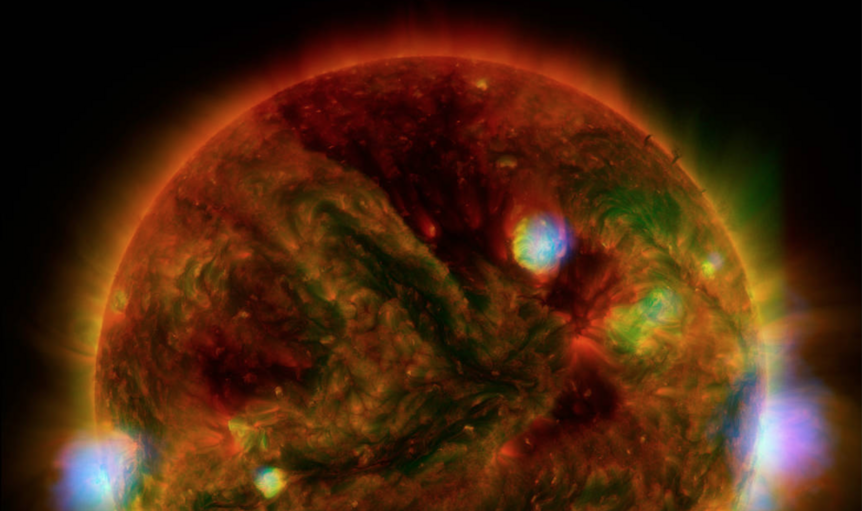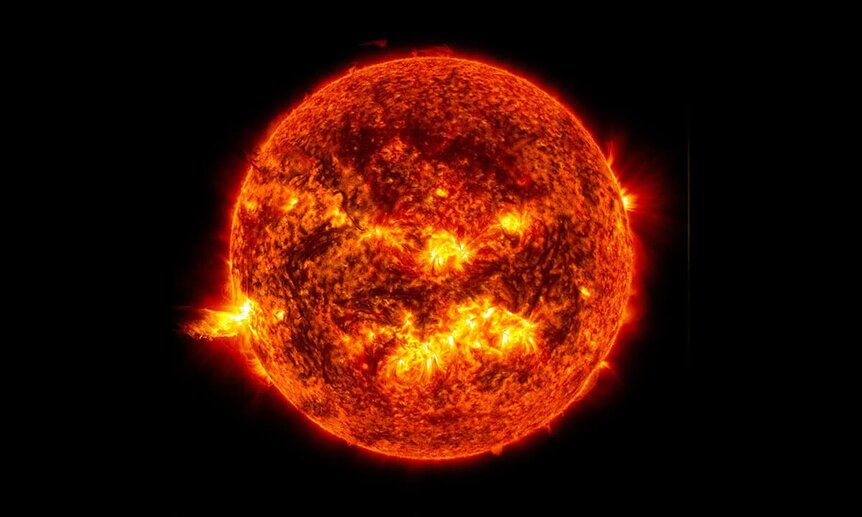Create a free profile to get unlimited access to exclusive videos, sweepstakes, and more!
Solar Maximum Will Be Earlier, Stronger, and Last Longer
It's going to be long, strong, and trying to get the electromagnetic friction on.
NBC’s hit superhero show Heroes (streaming now on Peacock) began with a rare cosmic event, a solar eclipse visible from all over the world. As the show opens, we’re introduced to the key group of characters strung across the planet from New York to Tokyo, all of whom are watching the same celestial event. That is strange, indeed, considering that Tokyo and New York are 13 hours apart, it’s hard to figure how a solar eclipse might be visible in both places at once. It’s a mystery hinted at but never truly solved within the show’s lore and it’s wholly impossible in the real world.
Still, we’re not above some wacky solar activity of our own, as demonstrated by a new report from the National Oceanic and Atmospheric Administration’s (NOAA) Space Weather Prediction Center. The new report takes into account the latest data on solar activity and predicts that Solar Maximum of Solar Cycle 25 will occur earlier, be stronger, and last longer than previously predicted.
What Does Solar Maximum Mean?
From our comfortable perspective 93 million miles away, the Sun appears as a static and reliable orb in the daylight sky. Whatever changes it might be undergoing are obscured by tens of millions of miles of distance and the filters of Earth’s atmosphere and electromagnetic field.
RELATED: The Moon’s Shadow Shapeshifts During Rare Hybrid Solar Eclipse
When astronomers get an unfettered look though, the picture becomes a bit more complicated. The Sun undergoes an 11-year cycle driven by its electromagnetic field. As hot, roiling plasma swirls around, it drags magnetic field lines around with it. Over time, that activity ramps up toward what’s known as Solar Maximum, which occurs in the middle of each solar cycle. That also marks the point at which the Sun’s magnetic field polarity flips, swapping the positions of the North and South Poles.
We measure the amount of solar activity and predict solar maximum by tracking the number of visible sunspots on the surface of the Sun and comparing them to historical data. However, we’ve only been tracking for 25 solar cycles, each 11 years long, which means we have a pretty small statistical sample size and our models necessarily have a certain amount of flux. It also means we’re able to refine our projections as more data comes in.
How Long Does Solar Maximum Last?
Predicting the arrival time, duration, and strength of solar activity is of increasing importance as solar flares and coronal mass ejections (CMEs) pose a threat to electronics, communications, and navigation systems.
A 2019 panel of experts convened by NOAA, NASA, and the International Space Environment Services (ISES) predicted that Solar Cycle 25 would follow roughly the same pattern as Solar Cycle 24, which was the weakest in the last century. Based on those initial measurements, Solar Maximum was predicted for July 2025 with a maximum sunspot number of 115, well below the average of 179.
RELATED: Earth Narrowly Missed a Solar Storm “Apocalypse” in 2012
The new model changes the story dramatically, pushing Solar Maximum a year earlier. “We expect that our new experimental forecast will be much more accurate than the 2019 panel prediction and, unlike previous solar cycle predictions, it will be continuously updated on a monthly basis as new sunspot observations become available. It’s a pretty significant change,” said Mark Miesch, solar cycle lead at the Space Weather Prediction Center, in a NOAA statement.
With recent data taken into account, astronomers now predict that solar activity will increase more quickly than previously predicted and peak between January and October of 2024. It will also be stronger than predicted in 2019, with a maximum sunspot number between 137 and 173. While stronger than Solar Cycle 24, it will still be weaker than the average.
An earlier peak could be good news for next year’s total solar eclipse, which will occur during or near Solar Maximum. Viewers within the path of totality might have a chance to see an especially active corona with the naked eye. In addition to studying the Solar Cycle for purely scientific reasons, continual updates of solar models could also inform launch and spacecraft maintenance decisions by giving organizations advance warning of solar activities.
But if you’re looking for answers about how the Sun triggers latent superhuman powers, you’ll have to watch Heroes, streaming now on Peacock.
































